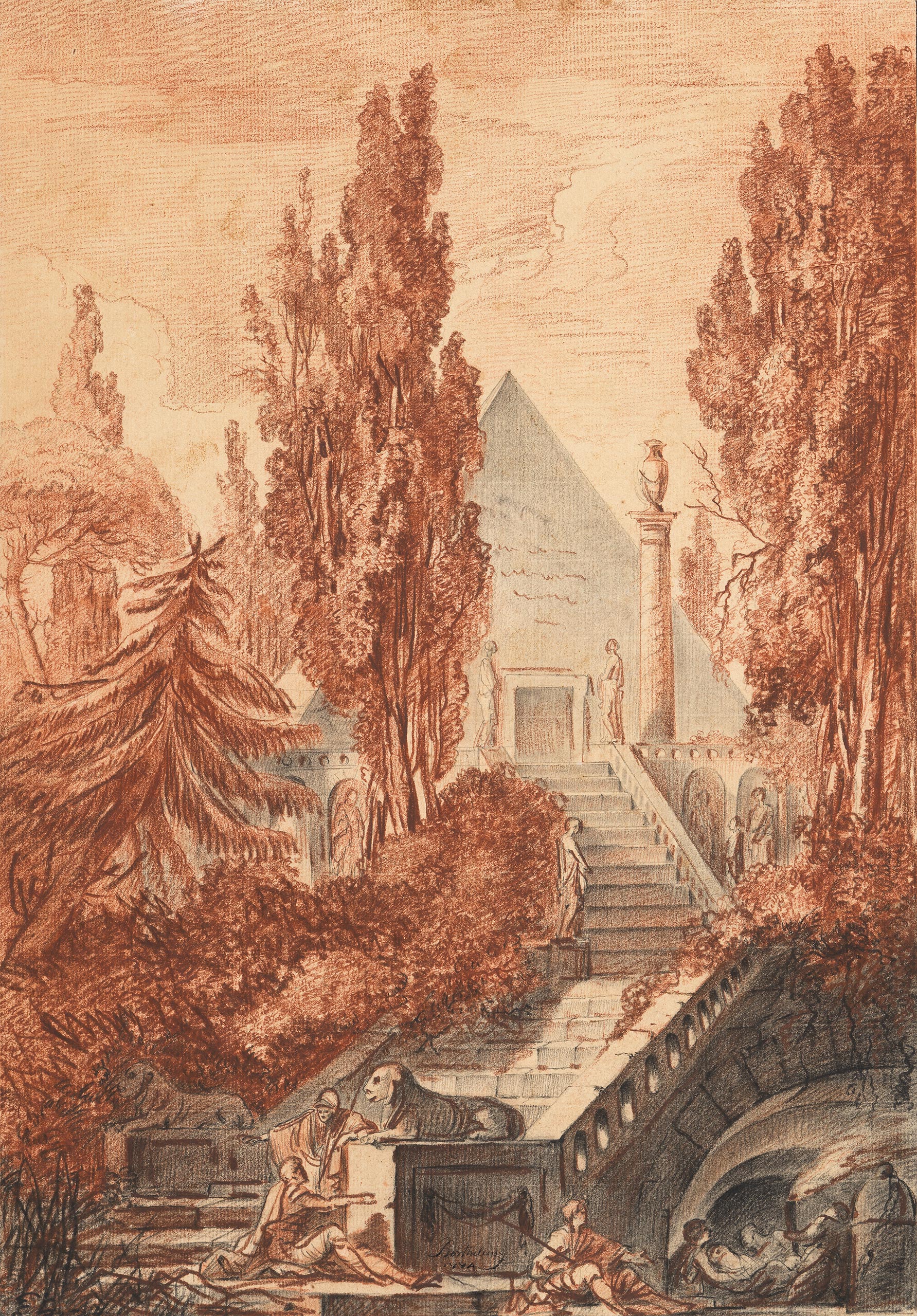
Berthélémy
Jean-Simon
Laon 1743 — Paris 1811
Funeral Rite at the Foot of a Staircase Leading to a Pyramid
Black chalk, sanguine, stump, black pencil.
Fine framing lines in pen and black ink.
Signed and dated in pen and brown ink Berthelemy 1774 lower centre.
435 x 303 mm (17 1⁄8 x 11 15⁄16 in.)
The son of a carpenter and sculptor from Laon, Berthélémy was sent to Paris to live with his uncle Jean Philippe Berthélémy, also a sculptor, who placed him as a student of Noël Hallé. Berthélémy won the Grand Prix at the Académie royale de peinture et de Sculpture In 1767 and spent two years at the École royale des élèves protégés. He already received a number of important commissions during this period including the decoration of the staircase ceiling in the Hôtel du Comte Saint-Florentin in Paris, and the ballroom ceiling in the Hôtel du Petit-Luxembourg for the Comte de Mercy-Argenteau, both buildings designed by the architect Chalgrin. In Rome, where he arrived on October 8th 1770 for the obligatory four-year stay, he was fascinated by the beauty of Italian nature and drew many landscapes. Our drawing is dated 1774, the final year of Berthélémy’s sejour in Rome, and reflects his fascination with architecture combined with lush Mediterranean landscapes; pines, cypresses, and yew dominate the architecture while scrub and bushes creep over the stone staircases.
Back in Paris, Berthélémy went from artistic to administrative success. Agrée to the Académie in 1777 and received in 1781, he continued a successful career as a decorative painter, working for the Comte de Vaudreuil to make two cabinets for the Queen at Fontainebleau, and later for the Empire at the Palais du Luxembourg. He painted themes from ancient history as well as nationalistic subjects (a vein that was greatly encouraged by the comte d’Angiviller’s politics in the 1780s) with La Reprise de Paris sur les Anglais (The Retaking of Paris from the English, Versailles, Musée national du Château), for example, while continuing to paint religious works even during the Revolution1. He was appointed costume designer at the Académie royale de musique in 1791, commissioner for the research of scientific objects in Italy in 1796 and curator at the musée central des arts from 1798. The opening of the musée des antiques was one of his main occupations. His beautiful portraits, particularly of Diderot, are also of note.
Nathalie Volle has assembled a body of graphic works that allow a characterisation of Berthélémy as a landscape painter placed somewhere between Hubert Robert and Fragonard. In other words, “halfway between the poetic immateriality of the former and the graphic precision of the latter”2. As the author points out, Berthélémy liked to choose strange viewpoints with elusive angles and blocked perspectives. This sheet, like View of the Scala della Girandola at the Villa d’Este also presented on our website, bears witness to this: the staircase begins almost on the lower edge of the sheet with no foreground space and rises towards a perspective-free view, blocked by hedges and tall trees in the background.
The Berthélémy landscapes recorded by Nathalie Volle are usually made in red chalk with the exception of Une entrée des catacombes (An Entry into the Catacombs) listed as not reappeared under no. 134 in the catalogue. Drawn in red and black pencil, this sheet was kept in the collection of M. Lemaître, a lawyer in Lyon in 1883, and exhibited in Laon the same year. Despite a slight discrepancy in dimensions, this is probably our drawing that shows corpses being carried into catacombs in the lower right corner. But there is nothing to rule out the possibility of another version since the artist occasionally made replicas of his compositions. Whatever the case, the combination of the two pencils is interesting and original. It allowed Berthélémy to achieve greater effects of shadow and contrast and increase the depth of view. Although the technique of using two or three pencils was widely used in the eighteenth century after Watteau’s example, it was rarely used for landscape drawings. Berthélémy seems to have enjoyed experimenting in this area: the Horvitz collection owns Vue du temple de Vesta à Tivoli (View of the Temple of Vesta at Tivoli) drawn in black chalk with white chalk highlights on a pinkish-brown tinted paper, an exceptional technique for this period that allowed for interesting half-tones (DF 1343). In our drawing, with its spectacular and rare effects, the artist shows himself to be just as innovative.
- This is evidenced by The Assumption produced for the Bernardines du Savoir-sous-Laon in 1790 and The Holy Family in Egypt made for the Saint-Esprit seminary in Paris.
- Nathalie Volle, Jean-Simon Berthélemy, peintre d’histoire (1743- 1811), Paris, Athena, 1979, p. 27.

